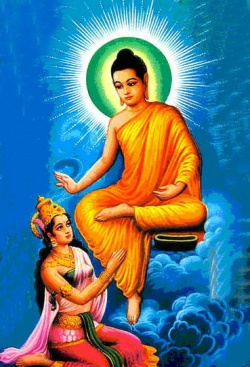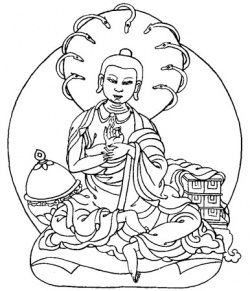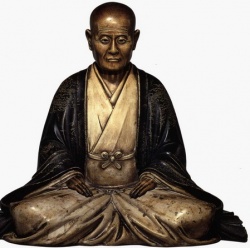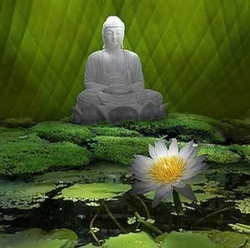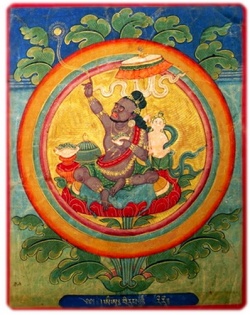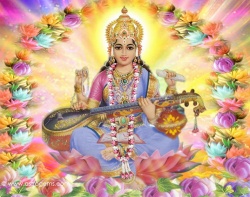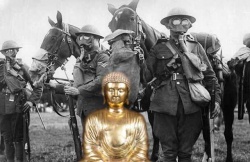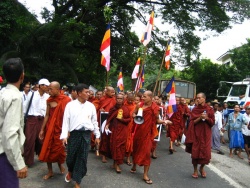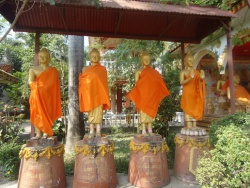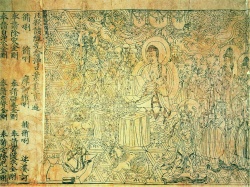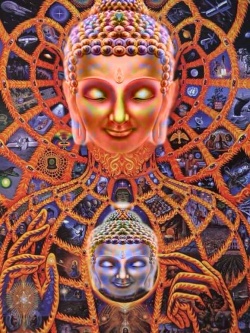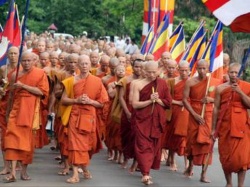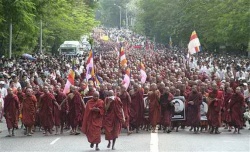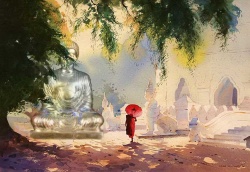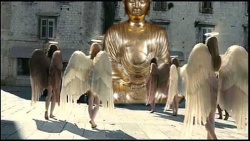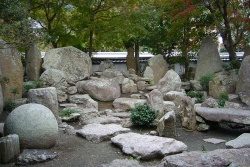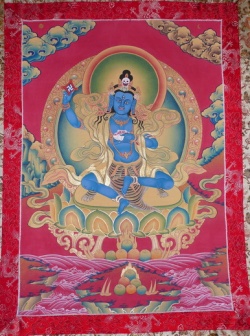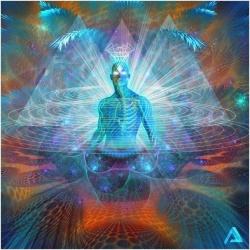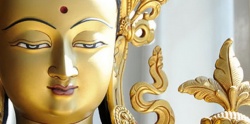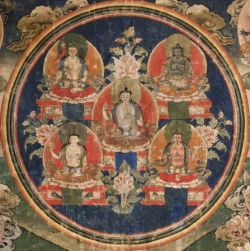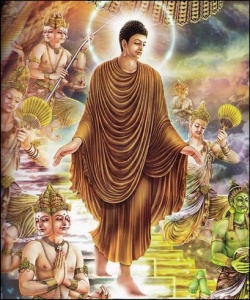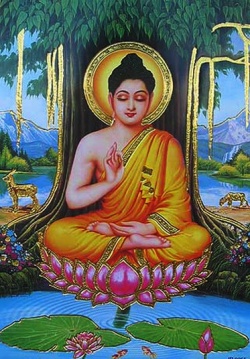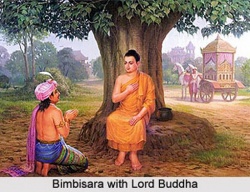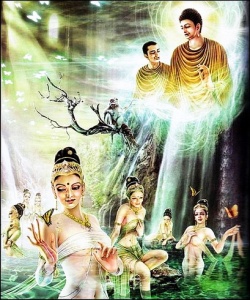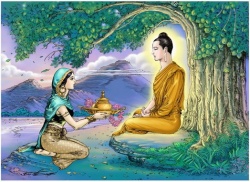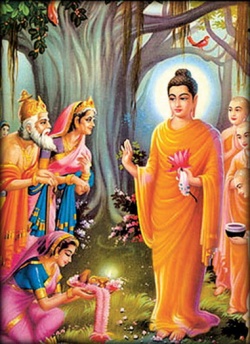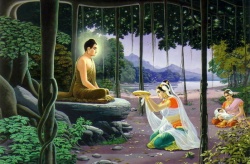Taking Refuge in Bodhicitta
Before we move on, let's talk about some basic ideas, which will make the following parts easier to unfold.
First let's talk about practicing Buddhism.
What are we practicing when we practice Buddhism?
The goal of practicing Buddhism is to reach Buddhahood, to reach the ultimate enlightenment. Simply put, to reach Buddhahood is to return to the original state of purity, which is primordial.
If it weren't original but obtained through efforts, sooner of later it will be lost without enough efforts or the right conditions.
This time you may win the championship, but next time it could belong to someone else. Thus anything in the world that is obtained through efforts isn't ultimately secured.
The original state was originally without problems. And the Original Purity is not the kind of purity that we usually talk about in defining cleanliness and dirtiness or likes and dislikes.
How things in the world are, are often judged by individual people's standards, which aren't absolute standards but are dependent on causal conditions.
The reason is that the worldly standards are often formed artificially and vary according to different environments, geographical regions and cultures. The Original Purity we talk about here is not formed by differentiation.
The original state of things clean or dirty has no artificial discrimination.
Even though colors are different, nevertheless, before we make distinctions they are blended together in oneness that is indivisible. Take the traffic lights as an example.
The red lights and the green lights don't distinguish themselves; it's only when they're functioning that they start to differ.
So they are not differentiable in themselves but are pure originally, which is the state before the arising of the dual distinction of subject and object.
Such purity resembles the love of a mother to her child. She loves her child so much that she simply cleans up the child's diapers whenever necessary without discrimination. Such an indiscriminate mind would consider the child's excretion as clean.
Therefore, if there isn't discrimination originally, then everything is in oneness.
In Buddhism there's a teaching on "non-self."
When we make distinctions, there are individual objects. However, just like the ocean or river, everything is in fact mixed, and one person is like one drop of water, one grain of sand, or one pebble in it.
A drip or grain of sand seems differentiable from the ocean or river; nevertheless, before it was distinguished the whole ocean or river was a unified totality. The truth is that all were originally in oneness, until we started to make artificial distinctions.
For another example, if one place on Earth suffers from some leak of poisonous gas, the people living nearby will surely be victimized. Those that live afar may not feel any impact.
Nevertheless, to the Earth as a whole, everyone shares any tiny leak of poisonous gas. Therefore, all are shaped by causal conditions, and are constantly evolving.
When we are able to make conscious distinctions, the distinctions stand. When we become too old or too ill, we won't even have the energy to grasp to such distinctions.
Thus all sentient beings and non-sentient objects are originally, as a matter of fact, in Limitless Oneness.
Any discrimination is temporary and artificial. If we observe things from atomic or even subatomic particles' point of view, the discrimination's shaped by our senses don't even exist.
Hence we could understand that the discrimination's we normally make are biased in the light of scientific microscopic or macroscopic views.
We often make distinctions in our worldly lives. For example, this is lawful right, obligation, or responsibility. Thus, all sorts of problems would become unsolvable, and people all suffer much.
When we are healthy we may have the energy to make differentiation and to fight over it, but when we encounter sufferings like those due to traffic accidents, senility, and illness, the problems would become even more insoluble.
So, when seen through, life is suffering with lots of afflictions. We could rarely smile from the bottom of our hearts.
After Sakyamuni saw the sufferings of old age, illness, and death, he gave up his power and role as a prince, reflected upon how human beings could pass their lives peacefully and overcome the sufferings of old age, illness and death, and he finally reached Buddhahood.
At first, he learned from the immortals then in India, and reached attainments in the Realm of Form and the Realm of No-form.
Still he found that there were problems and it was not the ultimate solution. It would be very hard for ordinary people to even reach these levels.
Therefore, at his level, it was not just a breakthrough in concepts. Nowadays the numerous establishments in the society are incapable of providing thorough help.
For example, if there were a flood, people would donate money to help.
But that would not prevent some other natural disaster from coming. Even though the homeland had been rebuilt, but the trauma in people's minds would not be healed at once.
Others could not help the victims unless they can open up their minds themselves.
Sakyamuni Buddha was capable of breaking through any subtle spiritual attachment, even released attachment to fine attainments of Dhyana, and returned to Original Purity. Limitless Oneness transcends spatial and temporal limitations.
When one reaches the state of Limitless Oneness, naturally there will be power that reaches to those that are in need of help. Things as such may sound like fairy tales.
But if you practice in accordance with Dharma, you will have experiences that come near to the transcendence of Limitless Oneness over spatial and temporal limitations.
After engaging in Dharma practices for many years, sometimes one would know about events in one's previous lives or foresee future events.
These are examples of transcending temporal limitations. For example, when I prayed on behalf of others, even though they were overseas they would feel power coming or see situations changed.
These are examples of transcending spatial limitations. These are real and can be experienced, and constitute what keeps me going on my life-long Buddhist practice.
With the above understanding, we are now ready to expound on "Taking Refuge in Bodhicitta."
What does it mean by "taking refuge"?
Once "taking refuge" is being considered on the path of Buddhist practice, we're no longer talking about the beginning phase.
Taking refuge seems to be the first step, but in real life who would suddenly believe in anyone? When we were little, our parents might have led us to take refuge in a Dharma teacher, but later when we grew up, our thoughts might have changed. So that need not be a case of taking refuge in earnest.
The real one comes when we ourselves sincerely want to return to the state of Original Purity and to look for a permanent and reliable settlement.
We can't achieve this by relying on our usual worldly approaches, so we need to look for something stable and secure.
Hence, to have reached this step, one had more or less known some Dharma, had learned what Buddha taught us, had realized what's truly beneficial to us, and thus wanted to take refuge, and would not run away afterwards.
This no longer belongs to the theoretical part of Dharma, but has exceeded the levels of "knowing" and "thinking" to reach the level of "practice." Only when one has reached the "practice" stage will there be genuine taking of refuge in the Dharma.
What then are we taking refuge in? We are taking refuge in the Original Purity
Nevertheless, this would be too far-fetched to ordinary people's experiences. Where would the "original" be? If it were originally there, then we need not do anything because it was originally there already, and we have never left it. Therefore, theoretically speaking, we need to take refuge in the Triple Gem.
We take refuge in the Buddha because Buddha was a person with the experience of right awakening, and had realized Limitless Oneness. Even though physically he had entered Nirvana, but in reality even now he can still help us and communicate with us.
However, ordinary people would not know how to contact sentient beings that had attained enlightenment, nor could they recognize such beings. Therefore, we need to depend on reliable teachings that came down to us.
Although there are lots of Sutras, they are basically about impermanence, non-self, and Bodhicitta. Correct teachings of this kind are what we ought to follow.
Thus, when we can't find the Buddha, we simply follow these teachings. As to taking refuge in the Sangha, some people with experiences in Dharma practices would know how to practice would be in accordance with the Dharma or not.
Such people are not confined to only monks or nuns, but also include lay Buddhists that have practiced long and obtained experiences of attainment. However, when it is thus understood sometimes certain problems would arise.
For example, some would claim to be living Buddhas, while those of us ordinary people would not know how to distinguish the real ones from the fake ones.
Furthermore, there are many schools in Buddhism, and also classifications into Hinayana, Mahayana, and Vajrayana.
And there are people who claimed that only certain teachings were authentic, as were originally taught by Sakyamuni. So how are we supposed to discern if the teachings were correct and if a person had real practice experiences?
There is one criterion, namely, to decide by the presence or absence of Bodhicitta.
If one could attain Limitless Oneness that is originally pure, that would be Bodhicitta. Nonetheless, it's almost impossible for us to reach such high position of fruition right away.
Bodhicitta has another meaning, namely, as an aspiration toward this goal—may all beings soon attain Buddhahood; it aims not only at one's own liberation but also takes into equal consideration the liberation of all sentient beings.
With such a goal in mind, whenever problems arise we could judge by checking to see if Bodhicitta is present or not.
This is because Bodhicitta contains neither selfishness nor predilection; it not only takes our own family members into care, but also embraces all sentient beings in the past, present and future.
It is an aspiration that wishes all to achieve ultimate peace and happiness, and thus solve the problems permanently.
Within the sphere of our capabilities we would help them in accordance with the wish-may all beings soon attain Buddhahood so that they would leave sufferings and attain happiness.
So whatever we do, in addition to wishing that they would overcome the current hardships, we also pray that through this Dharma connection they would eventually become Buddhas. Therefore, we need to practice diligently in order to help others leave sufferings and attain happiness sooner.
Some Buddhists are bothered by the fact that they could not persuade their family members to practice Dharma. If you want to wait till their conversion to start your Dharma practice, chances are you'll never obtain any significant result in practice for the rest of you life.
If, however, we treat everybody equally, and can see that people have their own courses and times of maturity in practicing Buddhism, and hence we just try our best to spread and preserve Dharma in the world.
Then, even if we died first, they could still have the opportunity to encounter Dharma. Such would be real salvation; otherwise, it would be just ignorance. Salvation activities that are wise would treat all equally; eventually it will reach everyone sooner or later.
So if we use Bodhicitta-may all beings soon attain Buddhahood as the criteria, there would not be deviations and mistakes.
Sometimes taking refuge in a Guru could possibly turn into idol worship. Besides, some teachings would say that only certain things are permissible and other things are not.
Even though Dharma is harmonious and would give different teachings to suit the propensities of different people; nevertheless, we could sometimes be unaware of our own confinement by concepts. But if we go by Bodhicitta, we will naturally know how to do.
Even if sometimes we got cheated, we will have nothing to regret for or to be ashamed of because all we want is for all beings to become Buddhas.
Therefore, being cheated or not becomes not an issue. In this way, we don't lose anything, but just approach ever closer to Bodhicitta time after time.
Now let's talk about taking refuge in Guru. In Tantric Buddhism Gurus are placed at the foremost place.
We take refuge first of all in Guru, and then we take refuge in Buddha, Dharma, and Sangha. Why is it that Guru is placed first in Tantric Buddhism?
The reason is that pure Bodhicitta is sustained in spirituality through Gurus from generation to generation. Buddhas transcend all spatial and temporal limitations. Some people said they could not find the real place to take refuge in.
I advised them to go in front of an image or statue of Sakyamuni Buddha and repeat thrice the Triple Refuge, namely, to repeat:
I take refuge in the Buddha;
I take refuge in the Dharma;
I take refuge in the Sangha.
Buddha treats all beings equally; so going to Sakyamuni is like turning to our own parents.
We could say to Buddha, "I think what you taught is right, and I am willing to follow your teachings and practice accordingly." Therefore, no one could say, "you can take refuge in Buddha only through me." All such claims are mistaken.
Therefore, transcending time and space, it is permissible to take refuge directly in the Buddha.
In Tantric Buddhism, the power to grant direct blessings could be transmitted from generation to generation. Since Buddha had entered Nirvana, even though he can still function, nevertheless ordinary people could not sense it.
Therefore, the power to grant blessing was transmitted to some great disciple. Hence, if from generation to generation the rules of conducts are well observed and genuine Bodhicitta is sustained, then the blessing power of Dharma can be retained in the world.
But if proper procedures or behaviors are not maintained, then the blessing power of the lineage cannot be preserved continuously, but will be taken back.
So lineage is like embers kept continuously in the minds of those carrying on the lineage teachings.
Hence, such a Guru amounts to being Buddha, and is indifferentiable from Buddha.
What could serve as a Dharma teaching may be decided by him. He is one that had mastered the paths, and can tell you what to do.
Even though what he said was not mentioned in any Sutra, he is actually teaching you how to practice Dharma. What are written in the Sutras are principles; as to how to apply those principles in daily life one should follow the direction of the Guru one has faith in.
Thus, you will gradually learn such Dharma as Giving, Law-abiding, Tolerance, etc. through the problems you encounter in daily life and through the procedures whereby you overcome the difficulties.
So, in Tantric Buddhism, if you do everything according to what Guru says, you will unknowingly realize that you have become different from others. Since you are used to being trained, many egoistic perspectives have been polished away.
Therefore, Guru includes Dharma. And since he is an expert in this, Guru of course also includes Sangha. Guru is even more important than Dharma, since he is the one that actually teaches you in person. Whoever feeds you with milk is the real mother.
Therefore, in Tantric Buddhism Guru is placed before Buddha, Dharma, and Sangha.
As to problems arising from following an incompetent Guru, this issue still needs to be decided by resorting to Bodhicitta. If your Bodhicitta were sincere, it would not become a real problem even if you followed a fake Guru.
You may even learn from the experience and develop the ability to differentiate the right from the wrong. Guru is unlike the abstract concepts of Buddha, Dharma, and Sangha.
If one truly intends to pursue the practice path in depth, then it is rather advantageous to have a genuine Guru to follow.
Ordinary people have limitations at many levels, even if they practice in accordance with Dharma principles, after groping for some time they might have gone astray and yet still could not realize the mistake.
This is because they have no way of recognizing their own limitations.
But if you have a Guru, you don't need to be well-versed in the Sutras, and yet through Guru's guidance, you will be able to apply Dharma in daily life.
Under the guidance of Guru, you will be able to escape from the unnecessary confinement that you used to self-imprison yourself.
With only one indication from Guru, you could move one step outward, and this step could be the blind spot that you would otherwise never notice. So it's very advantageous if one has a Guru to follow.
Way to Follow a Guru" on the handouts
Pao-Yuan Chen looked up twelve poems from over one thousand of my poems in Chinese.
Among the twelve, nine are directly related to the way to follow a Guru. You can tell they are arranged more or less chronologically from a few years ago up to now.
I wrote only when I had inspirations or when someone asked me some questions. In the past few years, I had actually written ten works in relation to the topic on how to follow a Guru.
One of the ten was entitled "Counterfeit," which is more on the negative side, and hence not included here.
Two of the twelve poems are of more general ideas and broader spheres, such as we can learn from all in the Dharmadhatu and hence all can be our teachers.
Another one is on the hardships we went through, if we can become liberated from within them, then such hardships may also serve as our teachers.
These two works are of broader scope, so I didn't include them under this topic.
After we read these poems, we can also see the differences in my view at different times with respect to the same topic.
Let's now read them one by one.
The Way to Follow a Guru
- Hard enough to know how to choose a Guru,
- Not to mention being turned off by a sour one.
- Be truthful to Bodhicitta and practice solidly,
- Approach gradually with eyes open, and dedicate oneself to the Dharma!
This poem is about how to stay near and rely on a Guru. Some people may be at first very devoted to some Guru, but later something happened, and they would become very discouraged and disappointed, and suffer deeply from it.
If we don't know how to choose, we should simply examine ourselves in the light of Bodhicitta and practice solidly step by step without aspiring toward sudden awakening.
If we find a Guru who doesn't covet for anything but knows what to do as matters arise, this is a genuine virtuous teacher. In this case, it would be better that we follow and practice solidly under this Guru.
We shouldn't turn to one Guru when someone says this Guru is good, and then turn to another when someone else says that one is good. If we keep turning around like that, we would be like floating duckweeds without roots to grow up on.
Each poem originally was written with a comment attached, which you could read by yourselves afterwards.
Blessed Ones are Few
- Addressing as "Guru" is easy but listening to is hard;
- One statement unacceptable would lead to disappearance.
- Serving with diligence and learning constantly in attendance,
- Only then could be blessed with Grace to turn into a dragon.
Those who had engaged in Buddhist practice would have opportunities to encounter Gurus that they could follow and rely on. However, one could not follow a Guru the way one makes friends nowadays. Some people might politely address one as "Guru" one day, but later, when he came with much expectation while what the Guru said wasn't what he liked to hear, he would simply disappear.
The real way to follow a Guru is to attend diligently and stay near the Guru for long years, and only then can one actually learn something.
You can't expect Guru to give you lectures everyday, as what you could learn from lectures are merely theories.
When you stay around your Guru, you will see how he deals with problems in daily life, and learn his ways of thinking and of handling matters, you can then actually learn little by little.
This is to learn through daily-life experiences. Only after long-term of such practice through imitation will one receive blessings and hopefully become a Dharma instrument capable of saving sentient beings.
Learning through Attendance
- Realization of Dharma permeates daily life;
- Behavior and conversation remain just ordinary.
- Attending the Guru to learn eventually the subtleties,
- Refined transformation would emerge unnoticeably.
The meaning of oneness of Dharma and life is that everything in one's daily life has become related to Dharma. There is nothing miraculous in this; just as ordinary people would do,
Guru greets people when he encounters people. But if you're with your Guru over long period of time, you will see how he handles matters and how considerate he is to others.
Ordinary people fall into different levels with different perspectives, so Guru even need to accommodate them in order to help them.
Then you will realize that to save sentient beings is so difficult—you have to self-adjust in order to accommodate sentient beings. Otherwise, before you could reach and help them, they would have run away already.
Therefore, if you are with your Guru over long period of time, and learn naturally bit by bit in daily life, you would naturally become a Dharma instrument after long-term nurturing.
Indicating
- Only humble attitude could benefit from guidance;
- Empty the mind in order to contain Dharma nectar.
- Learned indications revealed at opportune juncture;
- One poke brings to life the freedom to turn around.
One has to be humble in order to receive any teaching.
It takes an empty mind in order to thoughtfully and carefully attend Guru and follow every bit of teaching from Guru at all times. During this period worldly matters have to be put aside.
Whenever some matter arises, Guru's way of dealing with it differs from one's own thinking, then one might realize that Guru was thinking like that and hence handling like that. This is as if when you encountered a rock on the road, you don't really need to touch or move it.
Instead, all you need to do is to go around it. An indication like this from Guru turns your thinking around and shows the flexibility and liveliness of Dharma. So if you learn to deal with things differently, you could gradually learn the way to attain liberation.
Guru as Buddha
- Regarding Guru as no different from Buddha,
- In original oneness all distinctions fade away.
- Mind without grasping accepts things as such,
- Spreading Dharma to help all without waning.
In Tantric Buddhism, it is taught that one should regard one's Guru as no different from Buddha.
To realize Sunyata Guru is to help you return to the Limitless Oneness. Guru is one who whole-heartedly devoted to Buddhist practices and services of sentient beings.
If you cannot regard such a Guru as no different from Buddha, you will never be able to find someone qualified enough for you to practice being in oneness with others.
Guru is there for you to practice non-discrimination. There are no attachments in Guru's mind; all fixations are cast off.
This makes Guru very close to Buddha. Furthermore, Guru always propagates Dharma to benefit and help sentient beings.
Thus he is no different and inseparable from Buddha. Only if you could cease making differentiations, could the blessings from Guru be received by you.
If you cannot sense the blessings, it is due to your own graspings.
For example, some people are attached to the literal expressions of Dharma, and have too many personal interpretations with regard to actual practices, nonetheless, a real Guru would not argue with those people.
He will definitely say "That's OK"; otherwise, he would be the same as those people. However, when you are self-confined, you lose opportunities to learn from Guru.
Thus, if you just listen to Guru instead of worrying too much about theories, then you can learn the real stuff.
Teachable
- Only those that humble themselves could be taught;
- Apprentice begins after having attended the teacher.
- Sincere and obedient one gradually masters the role.
- Yet the current trend is like ordering courses in cafe.
To be close to Guru somewhat resembles the case of Zhang Liang who learned military strategies only after having helped tie the old master's shoes three times. Same rules apply to learning worldly knowledge.
If you want to become a barber, you'd have to clean up for your master for 3 years first. Then you'll start the learning from shaving winter melon.
Since you had attended the master for a long time, your attitude gradually became humble, and thus you will be able to learn from scratch.
Nowadays, people learn Dharma as if it takes only a prostration, an initiation, and then they're gone, just as they leave the restaurant right after the meal.
You cannot attend Guru closely in this way, and cannot really learn anything well.
Voluntary Refuge
- Where to place one's refuge is voluntary;
- Protector of liberation never coerces any.
- Compassionate concern spreads over all;
- Takes lots of wisdom and merit to follow.
Taking refuge in a Guru is a voluntary matter. Guru, as guardian master of emancipation, does not expect anything. Guru is always helping sentient beings that come in contact with him.
Those in need of help will gain benefits through his blessings. It takes accumulation of enough stock of merits and wisdom for a practitioner to encounter a genuine Guru.
Realizing Guru's Grace
- Guru entered Nirvana but has never ceased teaching;
- His absence in the flesh rendered real intentions seen.
- While strenuously upholding heavy load of salvation
- Real appreciation of the grace of lineage arose in me.
This poem is about receiving indications in dreams on how to handle matters from Guru Chen even though he had entered Nirvana. Although his physical body is no longer present, he has never stopped his teaching.
For example, the fire puja ritual that I composed recently originated from some inspiration received in a dream; I did it only because Buddha instructed me to do so.
Only thus will the ritual be truly helpful to people; it will not work simply because I think it will work. In a dream Guru Chen told me, "the third article in Zan Song Ji."
(That is the collection of praises composed by him.) Then he showed me a rectangular framed picture with some leaves in it that were left blank.
He told me to color them red. Upon waking up I rushed to check the third article in that book. It is a praise of the Great Compassionate Guan Yin.
To paint the picture into red means to compose a Red Chenrezig ritual based on the pattern of his fire puja rituals. Thus twelve years after Guru Chen's Nirvana and only with his permission did I compose the ritual.
Besides, I have composed only two fire puja rituals. The Manjusri ritual was composed only upon someone's request and after having received some inspirations. The Earth Treasure Bodhisattva ritual was requested, but I have not done it yet because so far I have not received any inspirational permission.
A few days before I performed the fire puja to Guan Yin for the very first time, I dreamed of White Garment Guan Yin and her attendant lady.
I wanted to make prostration, but they said no need. I did anyway. They both laughed. So I stopped.
Guan Yin raised her right hand and wrote some mantra in the air. Immediately I felt some power came to me and filled up the whole body. Previously, Guru Chen's rituals were designed for one type of activity each.
But nowadays there are more people asking for help through fire pujas, so I hoped to combine the three activities of pacifying, increasing, and inducing in one ritual. Guan Yin knew that this would require great spiritual strength, so she granted me the blessings.
With such blessings, I was then capable of performing the first Guan Yin fire puja to yield intended results. Therefore, although Guru Chen left his physical body, he is still incessantly helping and saving sentient beings beyond boundaries of time and space.
For example, although some people had never met Guru Chen, and yet they could still dream of him and receive teachings from him. Besides, people acted one way when Guru Chen was alive. Once he left us, most people showed different thoughts.
If he were still with us, I wouldn't have comprehended this. Thus we have to diligently continue Guru's Dharma services in order to realize Guru's grace of not abandoning us.
Now when I am sustaining the Dharma activities, Buddhas, Bodhisattvas and Protectors would gather to help and change situations. So when matters arise, if we uphold Bodhicitta, they would evolve themselves, and we don't need to worry.
Refuge in Guru
- Following orders faithfully is the tantric way to take refuge in Guru.
- Relying on someone to such extent could hardly be taken seriously.
- Long since one had realized Guru's attainments through inspirations,
- Only then knew one to abide by teachings sincerely and accurately.
In Tantric Buddhism it is taught that Guru's orders have to be followed.
However, it is very difficult to rely on a Guru to that extent and taking it seriously. In the biographies of ancient sages, some disciple would jump when the Guru said so.
This would seem insane to ordinary people. But the disciple was willing to do so because at his level he was capable of realizing that his Guru is genuinely no different from Buddha.
With such faith in Guru, the disciple was then able to receive Dharma transmission from the Guru, and was therefore willing to follow all orders from the Guru.
So when you follow a Guru, you should be able to comprehend that your Guru is genuine Buddha and is the representative of Buddhas and Bodhisattvas.
Many of those who can follow a Guru like this have had real inspirational experiences, which led them to realize the kindness, compassion and wisdom of Guru, and thus enable them to follow his teachings and guidance.
May all have ever-increasing Dharma opportunities and hence become attendants of virtuous Gurus!
